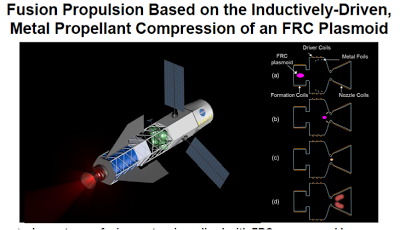John Slough could have an experiment in 2012 with a net gain in fusion energy of 1.6. It will be an imploding liner experiment. For space propulsion he is targeting a 200 times gain in energy output from what is input. Mission profiles are for 30 day or 90 day missions to Mars with over 5000 ISP.
* Lowest mass fusion system is realized with FRC (Field Reversed Configuration) compressed by convergent array of magnetically driven metal foils – steps (a), (b)
*Fusion neutron and particle energy is directly transferred to the encapsulating, thick metal blanket – step (c)
−Provides spacecraft isolation from fusion process
−Eliminates need for large radiator mass
* Expansion of hot, ionized propellant in magnetic nozzle – step (d)
−Produces high thrust at optimal Isp
Fusions Assumption:
• Ionization cost is 75 MJ/kg
• Coupling Efficiency to liner is 50%
• Thrust conversation ~ 90%
• Realistic liner mass are 0.28 kg to 0.41 kg
• Corresponds to a Gain of 50 to 500
• Ignition Factor of 5
• Safety margin of 2: GF =GF(calc.)/2
Mission Assumptions:
• Mass of Payload= 61 mT
• Habitat 31 mT
• Aeroshell 16 mT
• Descent System 14 mT
• Specific Mass of capacitors ~ 1 J/kg
• Specific Mass of Solar Electric Panels 200 W/kg
• Tankage fraction of 10% (tanks, structure, radiator, etc.)
• Payload mass fraction =Play load Mass
• System Specific Mass = Dry Mass/SEP (kg/kW)
• Analysis for single transit optimal transit to Mars
• Full propulsive braking for Mar Capture – no aerobraking
If you liked this article, please give it a quick review on ycombinator or StumbleUpon. Thanks

Brian Wang is a Futurist Thought Leader and a popular Science blogger with 1 million readers per month. His blog Nextbigfuture.com is ranked #1 Science News Blog. It covers many disruptive technology and trends including Space, Robotics, Artificial Intelligence, Medicine, Anti-aging Biotechnology, and Nanotechnology.
Known for identifying cutting edge technologies, he is currently a Co-Founder of a startup and fundraiser for high potential early-stage companies. He is the Head of Research for Allocations for deep technology investments and an Angel Investor at Space Angels.
A frequent speaker at corporations, he has been a TEDx speaker, a Singularity University speaker and guest at numerous interviews for radio and podcasts. He is open to public speaking and advising engagements.








